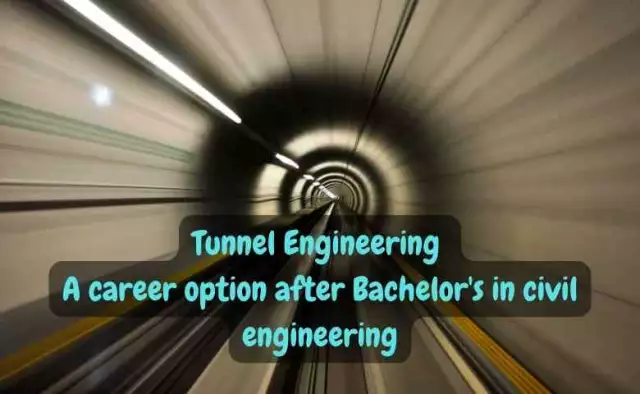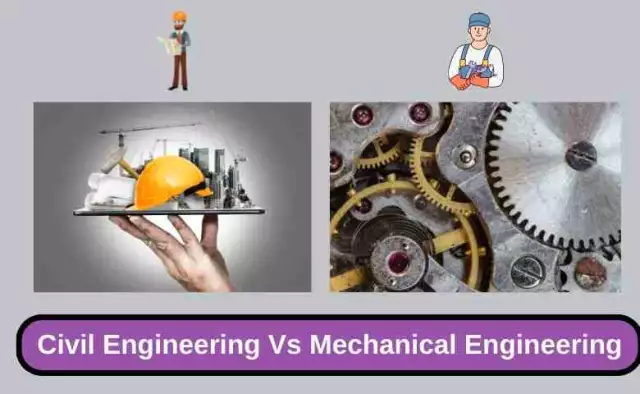Tunnel Engineering – A career option after Bachelor’s in civil engineering
Tunnel Engineering – A career option after Bachelor’s in civil engineering
Last Updated on July 20, 2022 by Admin
The continuing construction and upkeep of the transportation infrastructure needed to support our contemporary society depends heavily on tunnels. Our road and rail tunnels not only link towns, but they also serve as essential links that let people and goods to move more freely throughout our transportation networks, thereby facilitating continued population expansion. Significant engineering problems are frequently presented by tunneling, necessitating practical expertise, technical proficiency, and dedication to provide positive project outcomes.
A specialized area of civil engineering, tunnel engineering is largely a combination of geotechnical and structural engineering. A tunnel engineer is very knowledgeable about various types of ground (soil and rock), the behavior of the ground, and how the earth interacts with the construction that is built inside. An underground station or a road tunnel, for example, which typically have a design life of 100 years, are examples of structures that a tunnel engineer designs engineering solutions to safely excavate and support the ground and the structure to be built inside the tunnel.
Building tunnels is the focus of the civil engineering specialty known as tunnel engineering. There is a lot more to learn about this fascinating industry. Of course, no microscopic virus can justify keeping us from travelling for necessary reasons. Consequently, you will always have professional opportunities available to you.
What are the Tunnels?
A tunnel is a passageway that has been dug through the ground, rock, or dirt and is entirely enclosed, with the exception of the entrance and exit locations, which are often at either end. A pipeline is not a tunnel, even if some modern tunnels have been built using immersed tube construction methods rather than the more traditional tunnel boring techniques.
(adsbygoogle = window.adsbygoogle || []).push({}); A tunnel may be utilized for canal flow, rail transportation, or both pedestrian and automobile traffic. The main hubs of a rapid transport system are typically found in tunnels. Aqueducts that convey water for human consumption or hydroelectric power plants are examples of certain tunnels. Sewers are examples of other tunnels. Utility tunnels are used to connect buildings so that people and equipment may move about more freely. They also deliver steam, chilled water, electrical power, and communications cables.
Civilian tunnels are constructed for the purpose of transporting persons, contraband, and weapons, as opposed to military tunnels. For instance, wildlife crossing tunnels are built to let wildlife safely traverse barriers established by people.
What is meant by Tunnel engineering?
With knowledge and skills from civil engineering, geological engineering, mining engineering, mechanical engineering, electrical engineering, geophysics, geology, and other disciplines, tunnel engineering is a truly interdisciplinary field.
The following are the course’s primary modules:
Methods of Tunneling
Various techniques can be employed for the planning and building of tunnels, based on the size of the tunnel needed, the specific ground and groundwater conditions, the depth, the amount of space available, and other factors.
Prior to the invention of tunnel boring machines, this was often utilized for hard rock where digging was impossible (TBM). Although the procedure is slower than using TBM, it typically has fewer capital costs.
These powerful cutting booms-equipped track-mounted excavation machines are frequently employed in coal mining and civil engineering projects that call for a variety of tunnel sizes. They are fairly adaptable and can be equipped with additional machinery, such as gathering arms for spoil, dust-reduction water jets, and conveyors for debris removal.
This method, often known as “cut-and-cover,” works well for short tunnels. It entails creating an open trench within of which the tunnel is built. After that, the trench is backfilled. The building of the side walls may happen before or after digging the trench, depending on the state of the earth.
In a shallow trench, the “roof” slab of the tunnel is first constructed using the cut and cover technique. The tunnel can then be built underneath the “cover” and the trench can be backfilled. The benefit of is that it frees up the area above the tunnel for other purposes.
For tunnels that span deep water, this approach is appropriate. Prefabricated concrete or steel tunnel segments are lowered into a constructed trench at the level of the sea or a riverbank. The trench is subsequently backfilled, and any further safety measures are built above.
A driving pit is built using the trenchless process known as pipe-jacking, and pieces of steel or concrete tube are then hydraulically jacked forward from the pit to create the tunnel lining. When placing services beneath roadways, railroad embankments, and canals, it is necessary to cause the least amount of disruption possible. Since the Northern Pacific Railroad Company used pipe jacking for the first time in the United States in 1892, it has been widely adapted. Due to its simplicity and the fact that it prevents ground settlement, it is frequently chosen.
(adsbygoogle = window.adsbygoogle || []).push({});
Similar to pipe-jacking, however instead of a pipe, a box-shaped segment is jacked forward, which may allow for the creation of a larger tunnel.
This is mostly used for installing conduit and has a spinning cutting head that cannot be directed. As it inserts a tube or sleeve into the ground, a rail-mounted machine augers the surrounding dirt. The excavated material is moved back down the sleeve and into the shaft by the auger as it rotates, cutting the borehole’s face. The machine inserts a length of sleeve, which it then retracts so that another length of sleeve can be added and the auger flight prolonged. Then, this procedure is repeated. There are now also guided auger boring technologies available.
Micro tunneling machines, which can operate in nearly any type of ground condition, are generally used to bore tunnels that are too small for workers to access, such as pipelines. With the use of laser technology, micro tunneling machines can be operated from the ground up, and spoil is removed from the cutting face by an auger inserted into the pipeline as it is being built. This is frequently utilized in situations when there must be little surface disturbance, like when building urban drainage systems.
According to Kramer, “any procedures that install pipes with a diameter of less than 36 inches (900mm) to a specified line and level by remotely directing the cutting head” are considered micro tunneling. In 1992, Kramer et al.
This can be employed in areas with underlying materials that are capable of supporting themselves, like rock or strong clay. To develop the excavation, drill and blast methods or excavation with sprayed concrete liner are used.
(adsbygoogle = window.adsbygoogle || []).push({});
Specifically made tunnel boring machines (TBM) are employed in this method to excavate the entire needed cross-section. Although it requires fewer workers and can be very time efficient, such a machine has substantial costs associated with its purchase and maintenance. Whole face borers can cut through hard rock, with the debris being collected by a conveyor, but they can be rigid when it comes to changing direction or cross-section. They grab the side of the tunnel to transmit thrust ahead.
Advantages of tunneling
When compared to other approaches, the tunneling method has the following advantages that are listed below:
(adsbygoogle = window.adsbygoogle || []).push({});
Disadvantages of tunneling
The tunneling approach has some drawbacks as a result of its intricacy and difficulty. Among them are:
What does a Tunneling Engineer do?
Highly skilled civil engineers known as tunnel engineers are in charge of planning and overseeing projects involving tunneling. They are involved at every stage of the tunnel construction process, from the first design phases through the day the first car or train passes through.
There are numerous methods for creating tunnels, each requiring specialized knowledge and tools. Tunnels constructed using explosives, sprayed concrete coated tunnels, tunnels bored using tunnel boring machines (TBMs), and tunnels constructed using pipejacking, pipe ramming, or thrust boring are a few examples of these techniques.
(adsbygoogle = window.adsbygoogle || []).push({});
You need have in-depth understanding of construction methods, substantial expertise with civil engineering and tunnel design, and exceptional project management abilities to succeed as a tunnel engineer. A top-notch tunnel engineer can accurately assess the engineering requirements needed to execute the project and picture the entire tunnel construction. The following are the tunnel engineer’s primary duties:
(adsbygoogle = window.adsbygoogle || []).push({});
Skills required to become Tunneling Engineer
To become a tunneling engineer, you must possess the following technical skills:
You might also interested in
Essential qualifications required to make career in Tunneling
When planning and designing a tunneling project, a section engineer is engaged. This can entail creating tunnel constructions and acquiring the building supplies.
Salary details for Tunneling Engineer
Tunnel Engineer salary in India ranges between ₹ 3.3 Lakhs to ₹ 20.1 Lakhs with an average annual salary of ₹ 6.6 Lakhs. The salaries of Tunnel Engineers in the US range from $120,000 to $155,000, with a median salary of $147,000.
Final thought
A specialized area of civil engineering, tunnel engineering is largely a combination of geotechnical and structural engineering. A tunnel engineer is very knowledgeable about various types of ground (soil and rock), the behavior of the ground, and how the earth interacts with the construction that is built inside which makes them most curious professional. If you have the necessary skill sets, you can prove that tunnel engineering is the ideal career path for you.
Typically, universities do not offer courses in tunnel engineering. Instead, the specific skill set is acquired through work experience under the guidance of a capable mentor. Being able to watch the process of constructing the underground area is one of the wonderful things about being a tunnel engineer. No matter how much experience you have, the scope of these megaprojects is nearly incomprehensible.
(adsbygoogle = window.adsbygoogle || []).push({});



![09 Top Career Options After Engineering In India [2022 Updated Guide]](https://realiff.com/resources/assets/images/mainView/post.png)
![Top 28 Unconventional Career Options After Engineering [2022 Updated Guide]](https://realiff.com/assets/uc/Post/EukQPzGa0wh4/thumbnail_default.webp?RsBNfmtvnhn3)

![Construction Engineering Career [Ultimate Guide for 2022]](https://realiff.com/assets/uc/Post/qbGdUQRpdkUr/thumbnail_default.webp?ME2k0dNe2Go9)
